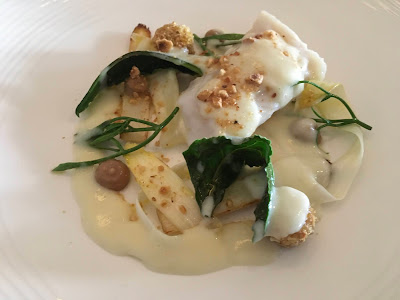Quite where the West Midlands ends and where the West Country begins is debatable. The big question to ask is “Is Gloucestershire in The Midlands or the South West?” I claim the northern-most two thirds of the county for The Midlands, certainly it was an important part of the Kingdom of Mercia, and allow what is the fairly recently invented administrative area of South Gloucestershire to be placed in the West Country. This gives a lover of West Midlands food the bulk of the highly thought of restaurants in Gloucestershire to add to his list of places to visit - nowhere more so than the fine and extremely affluent town of Cheltenham, location for a long time of what was the West Midlands only two Michelin starred restaurant, Le Champignon Sauvage.
So, on a fine June day with Lucy The Labrador necessarily resting in the coolness of the house, I set off for Birmingham city centre and to take the 40 minute train journey from New Street to Cheltenham and lunch at David Everett Matthias’ now one starred restaurant. I had lunched there twice before, both times when it had still held two stars. On the first visit the meal had been fine but not enough, I thought, to hold two stars and the second visit, not long before it lost its second star, was verging on the catastrophic with some fine, beautifully cooked little pieces of plaice near enough submerged in an unpleasantly bitter beurre noisette and under a monstrous pile of broad beans, rendered inedible by their sheer number. If any Michelin inspector had a similar experience then it is hardly surprising that the second star had been lost.
Still that was then and this is now ....
My most recent visit to Le Champignon Sauvage was an altogether happier experience. A lunch of great pleasure. The food served was immaculate and it was clear why the Michelin inspectors still favour this place. Finely judged, accurate, precise cooking where the ingredients indisputably completed each other; this was the work of a doyen, no gimmicks but still fresh and modern, I could wax lyrical about the meal for some time.
There was, as well, a doyenne in front of house, one who knows how to interact perfectly with her diners - Helen Everett Matthias, chef’s wife and she had excellent and charming support. The dining room looked fresh, bright and spacious and the several paintings on the walls added to the air of good taste matched with comfort and one felt one had permission to sit back and relax and enjoy what was to come.
And it was indeed hard not to enjoy what was to come. My dining companion had the set lunchtime menu which was extraordinarily good value with some excellent dishes which, though he is often a curmudgeonly sort, left him singing the restaurant’s praises and unable to find any faults.
I opted for the more expensive à la carte menu which was rather more than three courses. To start two delicious appetisers - a splendidly powerfully cheesy one and a “Please Sir I want more!” fishy one. Then there was a charming little bowl of savoury but not even vaguely wobbly pannacotta, the lack of wobble was not an issue, and a choice of four excellent-looking breads - we both chose a generously-sized onion-flavoured brioche. I was by then we’ll set on a course that told me that if I had not particularly enjoyed myself in the past, I was certainly going to do so that day.
And so to the dishes mentioned on the menu. A sumptuous starter of finely cooked, ‘lightly poached’ hake which emphasised Everett Matthias’ reputation for precise and perfectly judged cooking. It was a beautiful plate, bridal in its lovely whiteness, enhanced by the white asparagus and textured with the hazelnut bon bons. A scattering of sea herbs made their contribution to flavour and texture and their greenness added little contrasts of colour to add to the visual pleasure of the dish. What a memorable picture it makes and what a joyous memory the taste and texture leave with the diner lucky enough to have been served it.
For the main course I embarked on the dish of Highfield Farm poussin, Chef’s expertise shining through in its cooking, with poussin cream and and finely flavoured slowly roasted onion and seasonal asparagus, every dish should have one at this time of year. Another picture on the plate and a delight in the mouth.
The dessert alas was a disappointment to me. I chose ‘roasted white chocolate and apricot mousse’, apricot and basil sorbet and almond. What appeared was not what I was expecting - the mousse was served in cannelloni - fair enough though I did not pick up the flavour of apricot and this was served with a bitter chocolate sorbet sitting on a bed of crushed nuts and raspberries scattered around. The raspberries were a fine foil to the mousse but the bitter chocolate, which would have been a dream to the connoisseur of extravagantly dark chocolate, was far too bitter for the mousse and overwhelmed it. If there had been a problem with the apricot and basil sorbet then it would have been best to omit the sorbet altogether than to assault the mousse with the very bitter chocolate.
My happiness with the meal bounced back with the astonishingly excellent six different petit fours served with the coffee.
Apart from the dessert turning out to be different from what I was expecting and, I thought, the chocolate sorbet proving to be far too aggressive in flavour for the other ingredients of the dessert to bear, this was an excellent meal by, as I wrote above, one of the West Midlands’ doyens of restaurant cuisine.










No comments:
Post a Comment